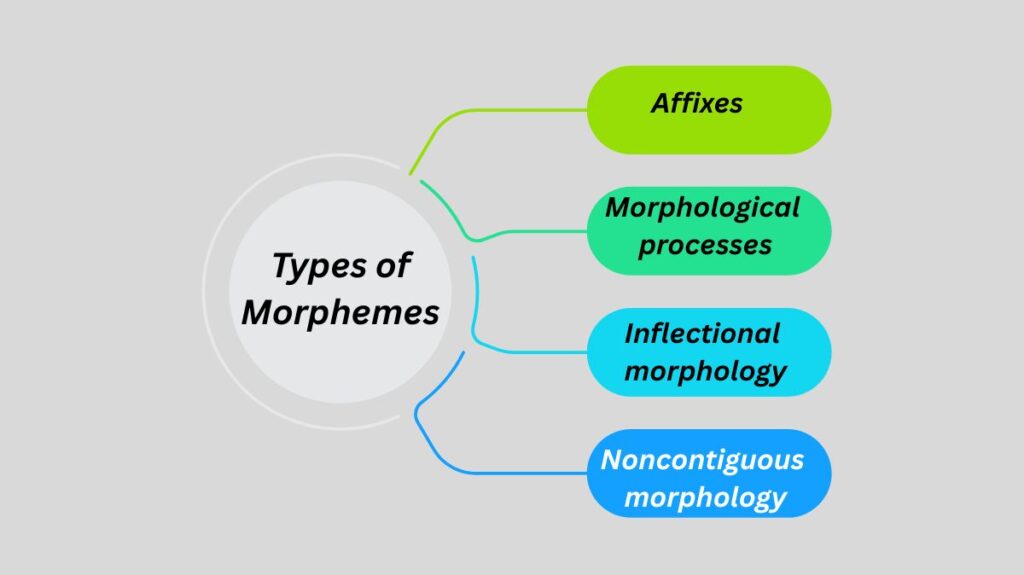This blog post explains about the Types Of Morphemes, Importance and Tasks
Morphemes
In the field of Natural Language Processing (NLP), morphemes are acknowledged as essential word constituents. They are described as a word’s smallest units of information conveying. They can alternatively be viewed as minimum meaningful elements or the language’s basic unit of meaning. These morphemes are thought to be the structural building blocks of word formations, and words themselves are thought to be constructed from them.
Morphology is the study of how morphemes join and the underlying structure and construction of words. In particular, morphological analysis examines how words are put together. A variety of mechanisms are used in human languages to combine morphemes and morphs (or segments), which are structural elements, to create word formations.
The following are important morpheme and morphological ideas found in the sources:
Types of Morphemes

- Affixes, like prefixes and suffixes, that affix to a word’s stem are examples of morphemes. Suffixes like -ed, -s, or -ly come after the stem, but prefixes like un- come before it.
- Morphological processes, such as the creation of the plural form (dog-s) from the singular (dog), can systematically link word categories.
- Inflectional morphology and derivational morphology are distinguished by the sources. The features of inflectional morphology tense, aspect, number, person, gender, and case often establish values within a predetermined paradigm. With a wider semantic range and the ability to alter a word’s part of speech, affixes like un-, re-, and anti- are examples of derivative morphology. In contrast to derivational morphology, which is less predictable, inflectional morphology is often productive and commonly used within a word class.
- Simple affixation (adding to stem edges) is only one type of combination. Ablaut (vowel alterations), stress shift, and zero exponence are examples of noncontiguous morphology that might indicate a discrepancy in meaning or grammatical aspects. Morphological paradigms can manage these challenging situations.
Importance of Morphemes
- The generative nature of language makes morphology essential. It is common for texts to contain new word forms that share morphological similarities with existing terms. The syntactic and semantic features of these new words may be inferred by NLP systems through a knowledge of morphological processes.
- There are a lot more inflectional forms in many languages than in English, therefore morphological analysis is more important than just listing all the word forms in a dictionary.
- More complex NLP tasks like parsing frequently start with morphological analysis, which entails comprehending the structure of words made up of morphemes.
NLP Tasks and Techniques involving Morphemes
Lexical Analysis: NLP’s first phase. It is a method of word-level text processing that registers the structure of a word. In lexical analysis, a fundamental objective is to tie morphological variants (various word forms, such as delivers, deliver, delivering, delivered) to its lemma (base form, such as DELIVER).
Lemmatization: Often called morphological analysis, this method distils a word to its lemma, or dictionary form. Depending on the NLP job, lemmatization is applied in different ways. For example, machine translation uses lemmatization to access lexical semantics.
Stemming: A more straightforward method, especially in information retrieval, that seeks to remove affixes from morphologically complicated words in order to reduce them to a canonical form, usually the stem. Simple principles are used by algorithms like as the Porter stemmer to do this without requiring a comprehensive lexicon. A thorough linguistic morphological examination is not always required for stemming to occur.
Morphological Inflection: The objective of this Natural Language Processing challenge is to generate an inflected form of a base word based on a requested inflectional request. While finite-state transducers and hand-crafted lexicons were used in the past, contemporary neural sequence-to-sequence models in particular, RNNs and LSTMs have demonstrated impressive performance.
Part-of-Speech (POS) Tagging: Categorizing words according to their grammar. Especially for new words, the internal structure of a word, especially its affixes (such as suffixes like -thy), can strongly suggest its likely part of speech. These morpheme-related orthographic patterns may be captured by neural networks using character-based embeddings calculated by LSTMs.
Word Embeddings: Studies have looked into the “interplay of semantics and morphology in word embeddings” and the use of neural networks to improve morphologically-informed word representations.
Finite-State Techniques: The mapping between word forms and their morphological characteristics, as well as the implementation of morphologically relevant spelling rules, may be handled elegantly with finite-state transducers (FSTs). Both morphological analysis and generation may frequently be accomplished with these models in both directions.
Lack of clarity: Sometimes a word’s form is unclear about how to break it down into its individual morphemes. The offered example, unionised, necessitates knowledge of the meaning and acceptable morpheme combinations. It may also be union + -ise + -ed or (in chemistry) un- + ion + -ise + -ed.
The fundamental components that convey meaning or grammatical function beneath the word level are called morphemes. For NLP activities ranging from simple text processing tasks like lemmatisation to more complicated ones like creating word forms or deducing attributes of unknown words, it is essential to comprehend their structure and combination (morphology).
